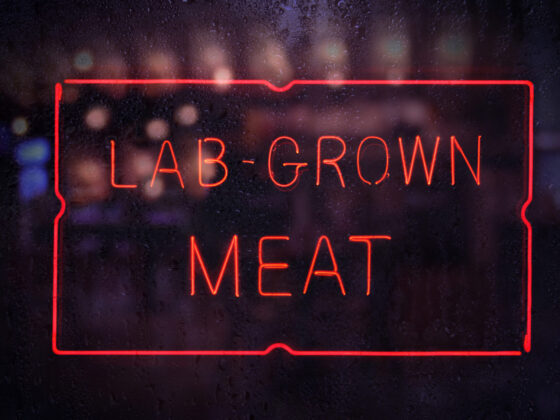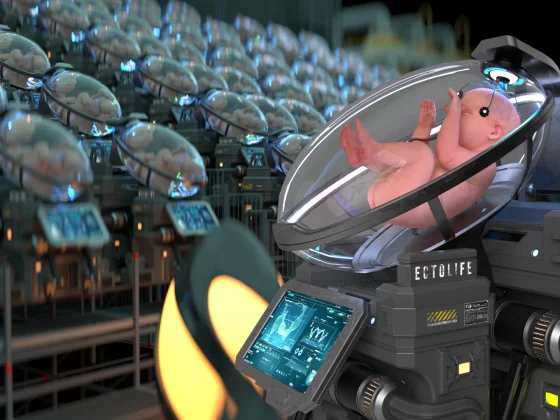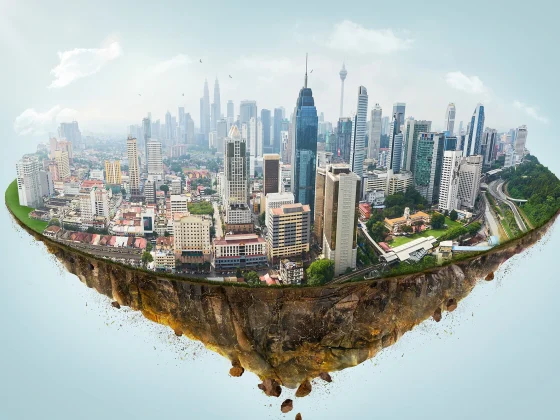By Tessa Lena, Article originally published at Tessa Fights Robots
After I published my interview with Paul Cudenec a couple of weeks ago, it inspired me to think more about what “progress” is, and how we got to the Fourth Industrial Revolution.
And here is what I am thinking at the moment. The notion of Nature vs. Technology is in itself a faux conflict! When we, human beings, the technologists, are balanced, the technologies that we come up with don’t wreak havoc.
Coming up with new technologies—in a broad sense of it—is a part of our wiring. However, there are very different ways to go about it, different mindsets. We can go about it in a spiritually grounded manner—with respect for life, and patience, and an honest evaluation of the tradeoffs and the consequences for our descendants—or we can go about it like mad rapists. The results and the ‘feel” of the two modalities will be drastically different!
So, as poor Greta shouts, “how dare you,” let’s tune out the shouting and talk about the nature and challenges of “progress.”
Technological dialectic: a hypothetical fable
You also deal with spiders and snakes and tigers and crocodiles and bears—but you don’t lament it too much because that’s just life, life comes with risks, and you are trained in how to face them—just like the alarm clock and the stooped posture and all sorts of car accidents and heart attacks and cancers are “just life” for an office dweller snacking on glyphosate-laden candy.
You know very well that everything in the universe is alive. Your entire life is an intricate, vibrant dance of relationships. And perhaps, it doesn’t even occur to you to do things that go against the natural and spiritual laws because, well, some things are just there because they work—you don’t insult your mother, and you don’t piss against the wind. You just don’t do it. You know it’s not a good idea, so you don’t do it. No need to experiment there.
As far as the mechanical technology goes, you have mechanical tools but they are simple—hence your muscles.
And so one day, you think, why am I walking to the river to bring water? Why don’t I make the river come to me? How do I do that? And then, being a sane person respecting life, you evaluate the bigger picture. Will be it be spiritually appropriate? Will it be safe for the future? Can it be done without throwing things out of balance? (Is it step one out of ten thousand from here to bringing about your descendant, a stooped office dweller, snacking on glyphosate-laden candy? 🙂
Let us say, you come up with a spiritually grounded way, and you invent a system of ditches and stone structures and gentle clay tunnels to create a “highway” for the river to come to you. Let us say, you tell your idea to your fellows, they like it, and together, you play with things and dig the ditches, and build yourself a nice water management system. And it works.
Hooray, progress.
PS. You may gradually lose some of your sexy muscles but hopefully you’ve thought about the tradeoff.
Aqueducts: an interlude
I found this story of a two-thousand year old Shawnee water management system stretching out almost six kilometers (please never mind the arrogant tone of the Scientific American article).
And this story of a three-thousand year old aqueducts in the Middle East (also written not without arrogance).
And the story of the Roman aqueducts.
And the Aztec Tenochtitlann aqueducts (below).

So it seems like it is generally possible to have water management systems without the industrial revolution and without glyphosate and “forever chemicals” in your morning muffins.
And here, for even measure, is an excerpt from a great book by Roxanne Dunbar-Ortiz’s, “An Indigenous People’s History of the United States”:
In the Sonora Desert of present-day southern Arizona, communities were practicing agriculture by 2100 BC and began digging irrigation canals as early as 1250 BC. The earliest evidence of corn in the area dates from 2000 BC, introduced by trade and migration between north and south. Farther north, people began cultivating corn, beans, squash, and cotton around 1500 BC. Their descendants, the Akimel O’odham people (Pimas), call their ancestors the Huhugam (meaning “those who have gone”), which English speakers have rendered as “Hohokam.” The Hohokam people left behind ball courts similar to those of the Mayans, multistory buildings, and agricultural fields. Their most striking imprint on the land is one of the most extensive networks of irrigation canals in the world at that time. From AD 900 to 1450, the Hohokams built a canal system of more than eight hundred miles of trunk lines and hundreds more miles of branches serving local sites. The longest known canal extended twenty miles. The largest were seventy-five to eighty-five feet across and twenty feet deep, and many were leak-proof, lined with clay. One canal system carried enough water to irrigate an estimated ten thousand acres.
It’s about the ability to evaluate the tradeoffs
For a second, let’s go back to our villager who wants to bring the river to his house so that he doesn’t have to walk so damn much every day for water.
What if he is thinking about building a water management system that resembles ours? Let’s imagine for the sake of this story that he knows how and can hypothetically do it.
Well, he would then need to start with a lot of metal piping. Hence, we would need to mine suitable metals.
But where? Right there in his backyard where, granted, there is indeed some metal underneath the ground …. but yikes!! That’s his house!!! No way!! Too loud and ugly!! Ah, forget it.
Like I said, the devil is in the detail.
Down the rabbit hole
I really liked Paul Cudenec’s example of trains and railroads that he mentioned in the interview. Let’s ponder Paul’s example.
So, we have all probably taken long-distance train rides as kids, and really enjoyed them. Trains are fun! You stare out of the window, do nothing, relax, and observe the changing scenery, the trees, the occasional cows and sheep, and rivers, and majestic hills and pretty buildings. Trains are definitely fun for a rider. I love them! But are they fun for the people living right next to the train tracks? Are they fun for the people whose pastures had to be torn apart in order to build the railroads?
And since the answer is probably “no,” then who is counting the collective tally—and is that person honest? Loving? Wise? Compassionate?? Fair? Qualified to be in charge of the collective tally?
Or, let’s say, I am in New York. Being in New York, I greatly appreciate the subway system. But, as much as I appreciate it, I certainly don’t want to live next to the train tracks. What do we do with that truth? How do we balance that tally?
Similarly, in the not so recent past, the COVID lockdowns very visibly separated the people into the beneficiaries of the convenient online delivery system, the “zoom class”—and the faceless (literally), overworked delivery donkeys. I didn’t see Jeff Bezos working extra shifts in his warehouse! Maybe I missed it? Similarly, in the 1920s, the DuPonts didn’t work at the conveyor lines producing poison gasses that were killing their workers. Etc. etc.
And so, it looks like the mold that shapes our “technological progress” is the fact that the financial backers and the opinion makers are usually in a strong position of maintaining a very substantial buffer between themselves and the toxins released in the process of producing the comforts (at least in their perception).

DDT was first synthesized in 1874 by the Viennese pharmacologist named Othmar Zeidler. In 1939, its insecticidal powers were discovered by the Swiss chemist Paul Hermann Müller, who in 1948, won a Nobel prize for it. A the time of discovery, Müller worked for the dye division of Geigy in Basel, Switzerland.
In 1942, Victor Froelicher, Geigy’s representative in New York, informed the U.S. military of the existence of DDT. When the U.S. military scientists studied the compound, they were blown away by just how effectively it killed a wide range of pests.
The army was in dire need of a powerful insecticide to curb typhus and malaria. The military people were very excited. During their short testing, they found that DDT didn’t immediately kill people, and they were happy that it was safe and effective. (Also, they set up a joint initiative with the Rockefellers, and the Rockefeller scientists sprayed DDT onto medical students, as a part of their testing. Etc. etc.)
The reason I am talking about it is that when Victor Froelicher, Geigy’s representative in New York, subsequently went on a “sales” trip to close the deal with the U.S. military, he ate a piece of DDT a size of walnut to convince them. Furthermore, he kept a lot of DDT around his house and didn’t mind it when his kid ate it. Which is to say, he himself believed that was safe and effective—and he was sincere.
However, shortly after the deal was closed, the FDA started finding alarming results and concluded that DDT was a human poison. Too late though!!! It was already being produced in large amounts for the army—and at good profits.
And after the war, it was just too lucrative to let go of. And then it took until 1962 when Rachel Carson published her “Silent Spring” for it to become a big debate—and then the EPA banned the use of DDT in the U.S . in 1972.
PS. There is a very convincing hypothesis showing that DDT caused polio-like symptoms, and polio went away when the DDT was banned (I wrote about it here).
PPS. Amazingly, DDT is on the rebound. In the early 2000s, there was a coordinated campaign to give DDT a “makeover,” and in 2006, the World Health Organization “declared its support for the indoor use of DDT in African countries where malaria remains a major health problem, citing that benefits of the pesticide outweigh the health and environmental risks.”
I suspect that if the people promoting “the march of technological progress” from their high chairs had to personally (knowingly) breathe in the exhausts and eat DDT- or radiation-laden seafood—if they really had to do it and there were not way for them to avoid it—we would be on a very different trajectory of progress.
And while we likely would still be occasionally making moves in the direction of “innovation” that poisons—we would be course-correcting the moment the poison touched the nose of the financial backer. And he would be paying good money to the scientists for honest science—because it would be his own precious nose on the line of innovation!
And that’s the paradox of our civilization—possibly best defined as Steven Newcomb’s System of Domination—it’s the juggling and redistribution of comforts and poisons in a manner that sweetens the lives of the people in high chairs and poisons the lives of the people at the bottom.
The Great Reset and the Big Green Lie: a matter of a thinning buffer?
For their own well-being and health—for them only—they want to secure vast green pastures and promote “nature conversation.” And so, they wag their fingers at us peasants about the environmental destruction (that they have funded), and they troll us with their mind-twisting propaganda.
Klaus Schwab and friends are using this very real paradox of our technological civilization to sweeten the lives of the people in high chairs even further—and to kick the people in the middle to the bottom, and the people already at the bottom to the bottom below the bottom. I think that’s what it’s about.
Liars.
The slow poisoning of the peasants
The engineer dutifully built the cellar. And then he became the first victim after the Nazi boss ordered him to stand on the lid, and then pressed the button.
I believe it was a fiction movie but the scene got stuck in my head. Something about it was existentially powerful. It’s the tradeoff. It’s the price of collaborating with a bully.
I believe that in a far less dramatic way, this is akin to what’s happening with the enthusiastic acceptance of the current version of progress (including the deceptively named “green economy”) by the comfortable people. People think that they are on the same team with the financial backers, that, if there were a big problem, the regulators would protect them—and that the wasteland left behind are somebody else’s problem.
But the Machine has been sliding down the hill without a sane operator for a while now…
DDT, to this, day, is present in Alaskan sea life (and the breast milk of local mothers), despite the fact that it wasn’t even sprayed there. Glyphosate is about everywhere. The skies are dripping with geoengineering poisons. Dementia, autism, and cancer are now considered “normal” (and that’s before the climate change 🥕 started causing heart attacks in children) etc. etc. And each individual person discovers the trap only when he finds himself in it. Just like in that fiction movie.
It’s the senses
And yes, there are still predators among us but, when most of us are in balance, the predators get neutralized without much trouble. The poisonous state of our world right now is maintained at the top by the predators—but it takes our compliance to give them power.
All change comes with tradeoffs. And currently, our tradeoffs are waaay out of balance—all while our tally counters, also known as policy makers, or “movers and shakers,” are dishonest, neurotic, impatient, unwise, and in the end, unloving.
When our senses are broken, when our thinking is fragmented, and when the leaders, whom we allow to lead us God knows where, do not love us—we, as a species, err on the side of making destructive choices that are either well-intended but myopic or straight out abusive. With time, misguided choices, accumulated over generations, do pile up—and then we end up with a world that is filled with ubiquitous poisons and linguistically upside down.
What now?
I don’t know what the future will look like as far as the balance of comforts and poiosons. The way it is currently going, we are getting fewer comforts and more poisons. 🙂 It will balance out eventually–because everything in nature inevitably balances out. But I don’t know when it balanes out—and how. In the meanwhile, I am living, and I plan to contunue enjoying every drop of it, to the fullest.
And the trickiest thing is, what will it take for many, many people to find their hearts at last and respect them? That, I don’t know. But no matter what others do, I do what feels right. In some way, it’s perhaps no different from having to deal with spiders, and snakes, and tigers, and crocodiles, and bears. It’s just life.
We are here. We are here for a reason.














